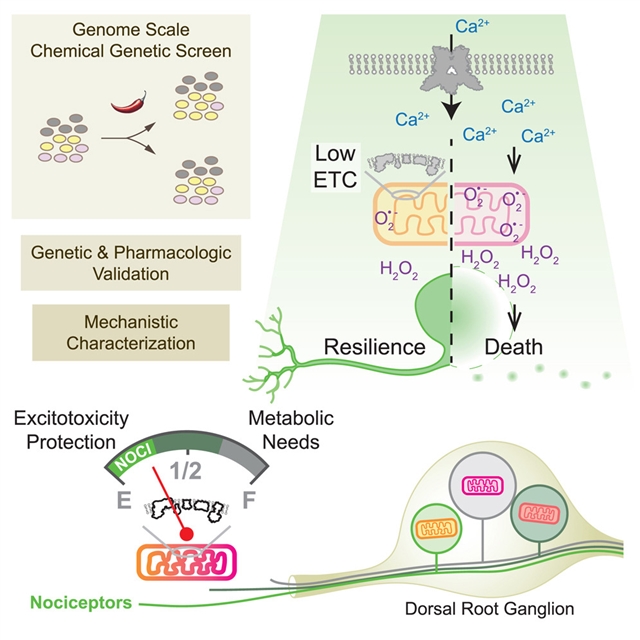
美国加州大学David Julius小组的最新研究提出了线粒体活动调节伤害感受器对兴奋性毒性的恢复能力。2025年8月26日出版的《细胞》发表了这项成果。
研究团队利用这一现象,通过全基因组CRISPRi筛选对兴奋性毒性进行了系统分析,从而揭示了一个全面的调控途径网络。该研究组发现,线粒体电子传递链(ETC)成分的表达减少,可以通过不同途径减轻钙失衡和线粒体活性氧的产生,从而防止辣椒素诱导的毒性和其他挑战。
此外,课题组人员通过功能获得和功能丧失实验证实了ETC在感觉神经元中的调节作用。有趣的是,与其他感觉神经元亚型相比,TRPV1+感觉神经元维持较低的ETC成分表达,能够更好地耐受兴奋毒性和氧化应激,这意味着ETC调节是一种内在的细胞策略,可以保护伤害感受器免受兴奋毒性的影响。
据介绍,辣椒素受体TRPV1介导痛觉感受器(疼痛通路的主要感觉神经元)对辛辣化学和热刺激的检测。TRPV1的过度激活通过钙进入和兴奋性毒性导致细胞损伤或死亡。
附:英文原文
Title: Mitochondrial activity tunes nociceptor resilience to excitotoxicity
Author: Lin Yuan, Navdeep S. Chandel, David Julius
Issue&Volume: 2025-08-26
Abstract: The capsaicin receptor, TRPV1, mediates the detection of noxious chemical and thermal stimuli by nociceptors, primary sensory neurons of the pain pathway. Overactivation of TRPV1 leads to cellular damage or death through calcium entry and excitotoxicity. We have exploited this phenomenon to conduct a systematic analysis of excitotoxicity through a genome-wide CRISPRi screen, thereby revealing a comprehensive network of regulatory pathways. We show that decreased expression of mitochondrial electron transport chain (ETC) components protects against capsaicin-induced toxicity and other challenges by mitigating both calcium imbalance and the generation of mitochondrial reactive oxygen species via distinct pathways. Moreover, we confirm the regulatory roles of the ETC in sensory neurons through gain-of-function and loss-of-function experiments. Interestingly, TRPV1+ sensory neurons maintain lower expression of ETC components and can better tolerate excitotoxicity and oxidative stress compared with other sensory neuron subtypes, implicating ETC tuning as an intrinsic cellular strategy that protects nociceptors against excitotoxicity.
DOI: 10.1016/j.cell.2025.07.048
Source: https://www.cell.com/cell/abstract/S0092-8674(25)00914-6
